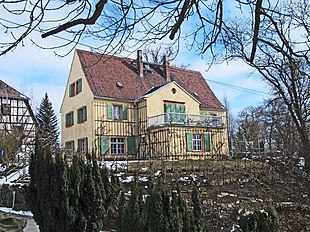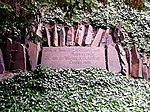Göschenhaus Grimma
The Göschenhaus Grimma or the Göschenhaus Museum in the Grimma district of Hohnstädt was the home of the publisher and bookseller Georg Joachim Göschen . It is located at Schillerstraße 25 in 04668 Grimma-Hohnstädt.
history
Göschen bought it in 1795 - together with the property next to it - from the horse breeder Wehnert. The estate consists of a three-sided courtyard with a barn, which is now used for catering or events. The buildings of the estate, apart from the residential building, are half-timbered . As in Göschen's time, these were used as a kind of inn for its guests. Today it serves as a pension.
In the house there is also a memorial for Göschen's proofreader Johann Gottfried Seume , who went on his famous walk to Syracuse from Grimma . Göschen published the complete edition of Goethe , but Goethe was dissatisfied with it. Göschen fared better with Christoph Martin Wieland and Friedrich Schiller . Seume corrected Klopstock's complete edition . In terms of content related to the Göschenhaus, the Seume-Haus is located on the Grimma market square, where the printing works and the actual publishing area were located. A plaque next to the entrance reminds of Schiller. Christian Gottfried Körner was also here. Körner was also Göschen's business partner in his Leipzig publishing house. Out of financial difficulties, Schiller had his Kallias relocated to Göschen's worst competitor, Johann Friedrich Cotta . That certainly meant a clouding of the relationship between Göschen and Schiller in the years 1794 to 1798, without, however, leading to a breakdown. Even Theodor Körner belonged to Goschen business partners.
The fact that this place, as a memorial, unfolds the effect with which it presents itself to today's viewer, is largely thanks to the commitment and collecting activity of Renate Sturm-Francke . Renate Sturm-Francke acquired the Göschenhaus in 1934, which was previously inhabited by descendants of the Göschen family. With her collector's items, she founded the Heimatstube Hohnstädt in 1950, which she established in her Göschenhaus from 1954 and which increasingly turned to Johann Gottfried Seume. In order to preserve the museum after her death, she donated the Göschenhaus to the National Research and Memorial Centers for Classical German Literature in Weimar in 1967 . In 1979 the Leipzig City History Museum took over the Göschenhaus as a branch. The Göschenhaus has belonged to the city of Grimma since 1995. The museum is the only publishing museum in Germany. Seume's collection includes his Russian sword, walking stick and a snuff box with his portrait that can be seen as authentic pieces.
museum
The Seumezimmer and the Biedermeierzimmer are furnished with classicism and Biedermeier furniture . The sea room is located in the hexagonal extension of the Göschenhaus, built in 1853. There is a small library in the Biedermeier room. The fireplace room with the valuable ceiling painting, old furniture and other objects, especially the pewter dishes, is now the popular meeting place for the so-called K – K – K afternoons: culture with coffee and cake, which can be traced back to Ms. Sturm-Francke. It is also used for weddings, concerts, readings and conferences. In an extension to the house there is a small collection of kitchen objects from the 18th to the 20th century as well as a small printing workshop to commemorate the printing work of Georg Joachim Göschen. On the upper floor there is a lecture room with a spacious balcony. The Göschenstube is located in a small annex , furnished with a small print shop and kitchen utensils.
garden
The garden with a total area of approx. 4,300 square meters is part of the memorial. It is the only private garden in Saxony designed and preserved in the classical style . It is laid out in the English style.
In the terraced garden are u. a. a small theater stage, the Amicitiae garden house , the friendship pavilion built in 1801 , in which z. B. two Klinen , portraits and chairs or small tables by Göschen and Seume are located. Under the temple-like garden house there is a cave-like vault, in which the up lifting of Bertel Thorvaldsen located. Thorvaldsen cast them around 1820 from an original he had created himself in 1816. Thorvaldsen made two casts of it, one of which is this Hebe in Göschen's garden! Seume must have been delighted at the sight of Antonio Canova's lift in Venice . The restoration of the lifting arm of this cast by Bertel Thorvaldsen was carried out by the Dresden sculptor Hempel. At the instigation of Renate Sturm-Francke, who saw the Hebe in a damaged condition on a vineyard near Radebeul in 1960, it was finally brought to Grimma by a helpful doctor in a camping trailer. It can hardly be doubted that Renate Sturm-Francke felt reminded of the meeting of the poet Seume and that of Canova during the lifting of Thorvaldsen.
Except for small statuary objects such as u. a. a lion and the circular fountain and a stone table made of porphyry with strikingly strong patches with wrought iron anchors with a bench, the small arcade with grapevines and the vineyard itself should be emphasized. Furthermore, there is a large stone with a verse by Schiller, which reads: Hurry to scatter thoughts and deeds into the furrow of time, which, sown by wisdom, bloom silently for eternity. The nursery is located behind the garden wall in the direction of the Seumepark.
literature
- Eberhard Zänker: Johann Gottfried Seume: A biography . Leipzig 2005, ISBN 3-936618-65-8 .
- Eberhard Zänker: Georg Joachim Göschen. Bookseller / printer / publisher / writer: A life in Leipzig and Grimma-Hohnstädt . Beucha 1996, ISBN 3-930076-27-6 .
- Bernd Erhard Fischer: Göschen & Seume in Grimma . 2. revised Ed., Berlin 2010, ISBN 978-3-937434-37-7 .
Web links
- Website of the Göschenhaus. Retrieved June 3, 2019 .
- https://www.wentzlau-webdesign.de/burgen/seiten/museen1/goeschenhaus/goeschenhaus2.htm
Individual evidence
- ^ Eberhard Zänker: Georg Joachim Göschen. Bookseller / printer / publisher / writer: A life in Leipzig and Grimma-Hohnstädt . Beucha 1996, ISBN 3-930076-27-6 p. 21 and 24.
- ↑ Bernd Erhard Fischer: Göschen & Seume in Grimma . 2. revised Ed., Berlin 2010, ISBN 978-3-937434-37-7 p. 14.
- ^ Eberhard Zänker: Georg Joachim Göschen. Bookseller / printer / publisher / writer: A life in Leipzig and Grimma-Hohnstädt . Beucha 1996, ISBN 3-930076-27-6 p. 32.
- ^ Renate Sturm-Francke. In: website of Großsteinberg. Retrieved June 3, 2019 .
- ↑ Göschenhaus in Grimma commemorates the founder Sturm-Francke. In: LVZ Grimma June 4, 2019. Retrieved June 4, 2019 .
- ↑ History of the Göschenhaus. In: Website of the Göschenhaus. Retrieved June 3, 2019 .
- ↑ Bernd Erhard Fischer: Göschen & Seume in Grimma , Edition AB Fischer, 2nd revised. Ed., Berlin 2010, p. 31.
- ↑ Bernd Erhard Fischer: Göschen & Seume in Grimma , Edition AB Fischer, 2nd revised. Aufl., Berlin 2010, p. 31. Unfortunately, it does not say which Hempel from Dresden it was, because there has been a sculpting company Hempel in Dresden for generations.
Coordinates: 51 ° 15 '8.9 " N , 12 ° 43' 53.6" E



